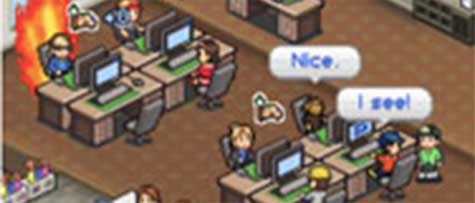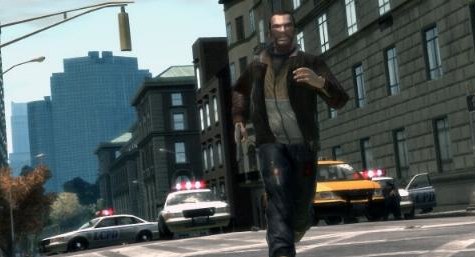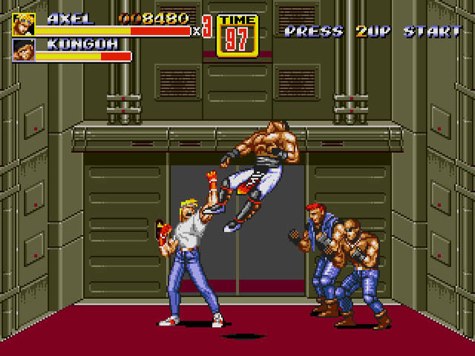Twenty years ago this month, in a small garage, two young games developers – well established on the shareware and doujin scenes – decided it was time to make some real money, and Gnarly Games was born.
Their first retail title, Bot Out!!, set the tone for early Gnarly: a good, solid game, hiding beneath somewhat puerile “attitude” that has dated all too fast. A sequel soon followed, although its full retail price belied the fact it was little more than an expansion pack.
The success of the Bot Out!! titles brought Gnarly enough success to move onto console. Bottulism!! took Gnarly’s attitude – and trademark exclamation marks – to the Microx SX, though it transport the Bot Out!! mascots to the world of scrolling adventure. Alas, Gnarly’s inexperience showed, and it wasn’t a success. Nor was War of Wars, their attempt at a more sober take on the scrolling adventure.
And so they returned to where they began: the puzzle game. Bot Out!! SX, though a straight port, was a big success with fans of the franchise and console gamers coming to it afresh.
Having finally found success on consoles, Gnarly moved to what would become a second home for them: Intendro’s Game Kid. Puzzle VAMPIRE applied a trend-hopping coat of fantasy horror to Gnarly’s experience in puzzle games, and PUZZLE ROBOT soon followed – a game that would fondly be recalled as an early peak of their skills in the puzzle genre. Their puzzling titles were ideally suited to Nintendro’s handheld – but they were soon to graduate from puzzles to something far more involved.
Ultra Bot was Gnarly’s first action title for the Game Kid, and their first game to break the $1m threshold. Whilst not a massive critical hit, it demonstrated their mastery of the console, and their move into action games continued with Ultra Vampire – a return to their fantasy universe – and a follow-up, Giga Bot.
If there’s a curiosity in the Gnarly catalogue, it is almost certainly their next title. Real Robot X, for the PCC-FQX, was an involved robot sim – something nobody saw coming. With impressive graphics, a highly involved set of controls, and an unforgiving difficulty curve, it was at best a cult hit. Though it now sells for large sums on the collector circuit, it was never a hit at retail, and Gnarly never returned to this console.
They did return to the robot sim, though: Real Robot P ported their PCC-FQX title to the portable with remarkable fidelity, and it became a real hit for them. Gnarly by now were maturing, their early frivolous titles having given way to serious fantasy and mecha games. Real Robot RPG was an expensive experiment in the RPG genre, and only really loved by fans. Internally, it was well-understood as an experimental title, that would pave the way for something much greater.
VampireVerse was the Game Kid’s first half-decent RPG, and despite average review scores was a sales smash. A swift sequel – VampireVerse 2 – married again-excellent sales to a stronger review scores, and still appears on fan-favourite lists to this day. The series even spawned a dungeon-crawler, Vampire Crawl.
Bot Tactics took Gnarly back to their SF universe, and despite strong sales was woefully expensive; so much so that they made an unscheduled, unplanned, and almost incoherent Reversi title – Revampiresi – simply to make payroll. Vampire Hack was, at the very least, a more credible attempt to make a bankable hit.
For Gnarly’s twentieth game, Gnarly made a bold statement by refusing to change its development title upon release. Game #20, as it remained titled on shop shelves, returned to their robot-action roots. Vastly expensive, with graphics and audio that pushed the aging Game Kid to its limits, it was a critical success, but despite strong sales ultimately made a loss. More restraint was displayed in the budgets of Vampire X and its follow-up, Vampire XX, which were highly profitable hits that put the firm back on track.
But it was a jump into a new universe that gave Gnarly its first million seller: Ninja X would be their final Game Kid title, and they went out with a bang: it was both a critical and sales smash, it would turn out to be a critical turning point in their career.
Ninja X gave Gnarly enough clout to move to Sonny’s PlayStatus, but the changeover to new tech nearly ran them dry, and they launched with the solid, if unremarkable Ninjaversi, buried in the educational market. Bot Out 3D – now sans exclamation marks – was a more credible return to form, transporting the popular puzzle title to the third dimension.
It took a while for Gnarly to find their feet in the 32-bit world. Vampire 3D, Megabot 3D, and even the popular UberVamp were all solid, well-liked titles, but acknowledged to be lacking something. It seemed as if the Gnarly of yesteryear had faded with their shift to the home console market.
That perception would be shattered by the wildly ambitious Vampire World – an online RPG in their popular fantasy universe. Singlehandled, it shifted countless PlayStatus Network Adaptors, and brought Gnarly the success they deserved.
They put that success to use in Bastard Cop, a misjudged game that aimed for a “mature” audience and fell somewhat flat. Reasonable sales couldn’t disguise a lacklustre game – and so Gnarly returned to what they knew.
What they knew was robots and vampires; what they didn’t know was that combining the two, in the remarkable Action RPG RoboVampire, would lead them to a 4m-selling hit. This, and shooter Hyper Robot X, propelled them to the major league – a promotion that some would argue was long overdue.
Of course, what wasn’t visible from the surface was the reality of making videogames. Gnarly came close to bankruptcy several times, and frequently resorted to contract work to make ends meet. Despite the success of RoboVampire, they did so again, knowing that the PlayStatus’ time was nearly up, and they would have to find a new home.
A year of contract work, and great investment, brought Gnarly to the Intendro DM. The DM was an obvious move: Gnarly had great success with the Game Kid, and were always more comfortable with handheld titles.
Despite the terrifying expensive of yet another change in tech, Gnarly found success, with Tera Bot DM – a game that poured their knowledge of the 3D action mecha game into a perfectly-formed handheld package. Successful beyond their imagination, it entered critics’ Hall of Fame, and spawned an even more popular sequel, Tera Bot DM 2.
It was that title that brought Gnarly their first success at the annual Game Awards – a fitting way to crown twenty years in the industry. And though it might have at times seemed like they would not survive, survive they did.
The only clue that remains to Gnarly’s age is, in fact, right in front of you: their name. In 19XX, it was an unironic attempt at cool from renegade nineteen-year-olds, desperate to make a mark. Now, despite wild success and changing trends, they hold onto that name: proud of where they are, unashamed of where they came from. That tells you all you need to know: at the heart of Gnarly Games, deeper than their love of giant mecha and bloodthirsty vampires, lies nothing less than great integrity.
Gnarly Games aren’t real, but the title they were founded in – Game Dev Story – very much is. It’s nothing more than a spreadsheet, really, but it’s an engaging and affecting spreadsheet, and it allows you to tell stories like this. In a subequent post – coming soon, I hope – I’ll explain what I like most about the game. For now, you’ll have to make do with pastiche journalism, generated from numbers on a screen.





